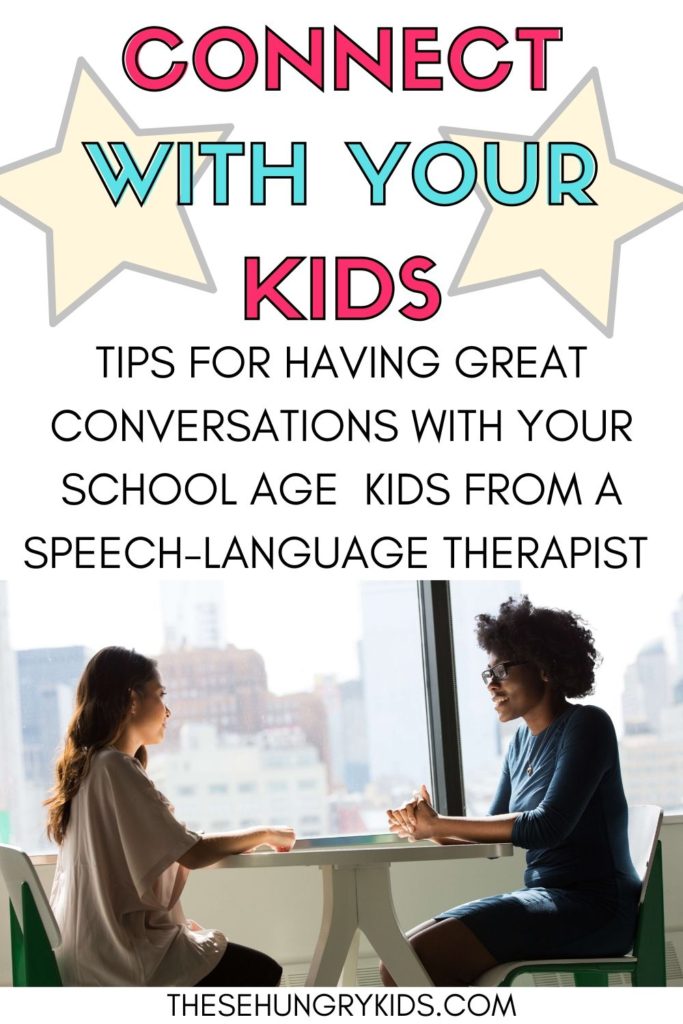This is a guest post by Freya of Happier with Tea. To learn more about Freya, read her bio at the end of this post.
Conversations are a crucial time for children’s learning. However, I often find that having great conversations with my school-aged kids is incredibly up and down.
Sometimes it’s amazing and wonderful- my kids are chatty and conversation flows. At other times, our conversations are like pulling teeth. It’s hard to get a conversation going and even more difficult to maintain.
Interactions are so crucial- it’s how children learn! It’s through interacting with people around them that their language develops, as well as their social skills, problem solving, theory of mind and more.
These 5 strategies will give you some ideas on how to have great conversations with your school aged kids, and how to optimize your interactions so you are using these times to teach them.
Kids are like sponges- they learn best when they are interested and engaged. Try these easy ideas to see how your role as a parent can make all the difference.
You might also like to check out these strategies to boost speech and language for busy parents, especially if your kids are a little younger.

1. CONSIDER THE ENVIRONMENT
The environment is something that we need to carefully consider if we want great conversations with our kids. We’ve all seen examples that make us cringe- families out to dinner together but heads buried in their own devices.
At home, we often might have the TV on, even if it’s just in the background, we might check our phone and respond every time in buzzes, and we might spend a big chunk of time on our laptops and iPad, doing work or sometimes just surfing.
Whatever your views are on technology, the fact is it’s a major part of most school-aged kids’ lives. They learn through technology in school, they’re given home assignments that require technology, and technology is now even a massive part of their social lives.
That’s not changing anytime soon so it’s up to us as parents to put in the parameters around this. Technology is great, but we also need to safeguard some time for communication and interaction with our kids.
This might be as simple as making a ‘no technology at the table’ rule. I have also heard of a family who have gone even further.
As a family, they have agreed to have:
- One device free evening each week
- One device free weekend each month
- One device free week each year
Without technology as a barrier, the quality of our conversation can skyrocket. It’s worth evaluating your current technology and device use and making a plan for some tech free time!
2. CHECK YOUR COMMENT/QUESTION RATIO
I know that I’m guilty of lapsing into drill sergeant mode at time with my kids- sometimes even without meaning to.
I want to start a conversation… but it can be all too easy to dive in with too many questions straight away.
Maybe you can identify with this example:
“Honey, how was your day at school?”
“Good.”
“Did you have that big test?”
“Yeah.”
“How did it go?”
“OK.”
“OK good. So- what did you have for lunch today?”
Can you see the pattern? It’s question after question.
We don’t realise it as adults, but questions change the dynamic of a conversation. They add extra pressure and even change the ‘conversational power’ of the conversation. Questions give all the power to person asking them. And as a result, they can cause the one on the receiving end to close off a little or even to shut down altogether. Ironically when this happens, the adult usually asks even more questions to try to get the child to open up again.
Because of this, questions aren’t the best way to start a great conversation like we might want.
So if questions won’t work to start a great conversation with your school-aged kids, what will work instead?
When you’re having a conversation with your kids, think about the comment to question ratio. Think of it as the ‘5 Finger Rule.’
Aim to make four comments before asking one question. The comments might be about yourself (e.g. “I had such a busy day today” or it could be flipping your question around into a comment (e.g. “I was thinking of you with your test today.”)
After each comment, it’s important to wait! Count to 5 in your head. Great conversations need this kind of space- it takes the pressure of your child and gives them extra processing time. It also gives them space to contribute if they want to. After you’ve made 4 comments, then you can ask a question.
This strategy is so hard to monitor- all too often a question slips out before I’ve even realised it- but it’s worth it. You’ll find that your child gives you longer answers than if they had just been answering your questions. Using comments also gives space for the conversation to go in a different direction than you might have expected!
Overall, reducing questions makes the conversation balance much more equal which is so important for a great conversation.
3. MODEL DON’T CORRECT
Depending on how old your kids are, it’s likely they are still figuring out all the grammatical rules of the English language. That’s totally normal! Speech and language develops in stages, and the complex grammatical rules are some of the last to emerge.
When you notice a mistake, model the correct version- don’t correct!
When you correct you only draw your child’s attention to the error and you have stopped a great conversation in its tracks.
Instead, repeat back what they’ve said in a natural and relaxed way with the correct version.
If your child says, ‘look two horse!’
You might say, ‘wow, yeah, two horses! Two black horses!’
Using this strategy allows your child to hear the correct version, but it also shows that you’ve listened to your child and affirmed what they said. And above all, you’ve kept the conversation positive which is when children learn best!

4. BUILD EMOTIONAL LITERACY
Emotional Literacy is the ability to recognise, understand and deal with emotions. It’s an important part of developing social skills, and is also a protective factor for all of life as it leads to better health, academic achievement and stronger relationships. Poor emotional literacy is linked to early dropout from school and engagement with youth justice!
Children learn the foundations of emotional literacy from their parents- this occurs in everyday interactions. When you have school-aged kids, keeping emotional literacy in mind will help to make a great conversation.
You can achieve this by doing 2 simple things:
- Build their emotional vocabulary. Label their emotions within everyday conversations. You might say, ‘wow, that must have made you feel worried’ or ‘you seem really proud about that.’
You’re helping them to unpack and understand their emotions, and giving them the words to express themselves. You can also suggest a way to deal with the emotion. ‘You seem really upset. Why don’t you do something you like to make yourself feel better?’ By doing this, you’re giving them the strategies they’ll need for life.
- Live Out Loud– your kids learn their emotional literacy from you. Unfortunately, a lot of their parents problem-solving happens internally. Your kids usually don’t benefit from seeing how you use positive thoughts, problem solving, calm down strategies, or any other internal scripts you tell yourself.
To make a truly amazing conversation, voice some of these thoughts for your child’s benefit. You could say, ‘wow this is really difficult. I’m getting frustrated. I need to remind myself that I can do it. I’ll take a break and remind myself that I can do it. Then I’ll come back and try again. I know I’ll be able to do it.’
This strategy will also help your child to develop a ‘growth mindset’ which can help them to be more resilient in life.
You may also like:
71 Activities to Do at Home With Kids
Ways to Burn off Your Child’s Energy Indoors
5. EXPAND AND EXTEND
Expanding is about adding a little extra to what your child says. If they say, ‘look, a big spider!’ you could expand this and say, ‘yeah, it’s a big scary spider that’s scuttling around!’
By doing this, you are affirming what your child has said, and you’re improving their vocabulary. By expanding with lots of different types of words (e.g. descriptive words and verbs), you can massively boost your child’s vocabulary.
Extending is about adding a new idea into the conversation. You can encourage your child to use their imagination, to problem-solve, or to consider something from another’s perspective.
For example, if your child says, ‘that boy’s crying.’ You could extend and say something like, ‘yeah I wonder what upset him’ or ‘what do you think might cheer him up?’
Both expanding and extending are strategies that will develop your child’s language and thinking. When you have school-aged children, these are brilliant strategies to keep in mind for a great conversation.
AND THAT’S IT!
If you have school-aged kids, try out these 5 strategies to and enjoy great conversations together. Not only will it grow your connection and relationship, it’s also a time when your child will learn so much from you- skills that will equip them for all of life.
Freya
About the Author

Hi, I’m Freya- a blogger, writer, and Speech-Language Therapist. I love my job and the opportunity every day to share my knowledge and experience in this area.
My passion is to help other parents to be intentional in key areas such as developmental milestones, play, language development, behavior, school readiness, literacy, and educational achievement.
What you do at this stage impacts your child far, far into the future- so be an Intentional Parent!
You can follow Freya on her blog Happier with Tea, or on Twitter and Instagram.

